Music
Trailers
DailyVideos
India
Pakistan
Afghanistan
Bangladesh
Srilanka
Nepal
Thailand
StockMarket
Business
Technology
Startup
Trending Videos
Coupons
Football
Search
Download App in Playstore
Download App
Best Collections
Technology
Facebook on Monday announced a number of updates aimed at video creators and publishers, during a session at the International Broadcasting Convention (IBC) taking place in Amsterdam. The updates involve changes to live video broadcasting, FacebookWatch Party and Creator Studio, and they include enhancements to tools, expanded feature sets and improved analytics, among other things.
The highlights include better ways to prep for and simulcast live broadcasts, ways to take better advantage of Watch Party events, new metrics to track video performance and a much-anticipated option to schedule Instagram/IGTV content for up to six months in advance.
Live video
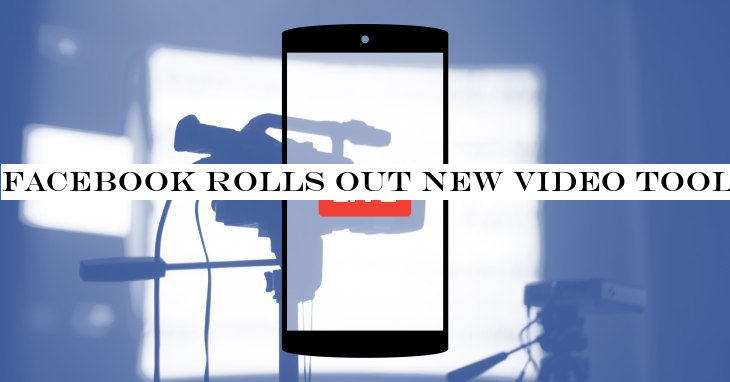
In terms of live video, Facebook says it listened to feedback from those who have been broadcasting live on its platform, and is now rolling out several highly requested features to Facebook Pages (not Profiles.) The changes are an attempt to better accommodate professional broadcasters who want to use Facebooklive broadcasting capabilities instead of or in addition to other platforms, like YouTube.
Through the Live API, publishers can now use a &rehearsal& feature to broadcast live only to Page admins and editors in order to test new production setups, interactive features and show formats before going live to a full audience. QVC has tested this feature, as they broadcast live on Facebook for hundreds of hours per month, and have wanted to try out new workflows and formats.
Publishers will also be able to trim the beginning and end of a live video, and can live broadcast for as long as eight hours — double the previous limit of four hours.
This latter capability has already been used by NASA, which broadcast an eight-hour spacewalk, for example, and it also leaves room for broadcasting things like live sports, news events and Twitch-like gaming broadcasts.
Most notably, perhaps, is that the company realizes live broadcasters need to serve their audiences outside of Facebook. Now, publishers will be able to use apps that let them stream to more than one streaming service at once, by simulcasting via the Live API.
Live video recently rolled out to Facebook Lite, as well, the company also noted.

Watch Party
Facebook additionally announced a few new updates for its co-watching feature, Watch Party, which include the ability for Pages to schedule a party in advance to build anticipation, support for &replays& that will let others enjoy the video after airing, the ability to tag business partners in branded content and new analytics.
As for the latter, two new metrics are being added to Creator Studio: Minutes Viewed and Unique 60s Viewers (total number of unique users that watched at least 60 seconds in a Watch Party). These complement existing metrics like reach and engagement.
The Live Commenting feature, which allows a host to go live in a Watch Party to share their own commentary, is also now globally available.
Creator Studio
And wrapping all this up is an update to Creator Studio, which is what publishers use to post, manage, monetize and measure their content across both Facebook and Instagram.

The dashboard will soon add a new visualization layer in Loyalty Insights to help creators see which videos loyal fans want to see by measuring which videos drive return viewers.
A new Distribution metric will score each videoperformance based on the Pagehistoric average on a range of metrics, including: 1 Minute Views, Average Minutes Watched and Retention. This feature, rolling out in the next few months, will offer an easy-to-read snapshot of a videoperformance.
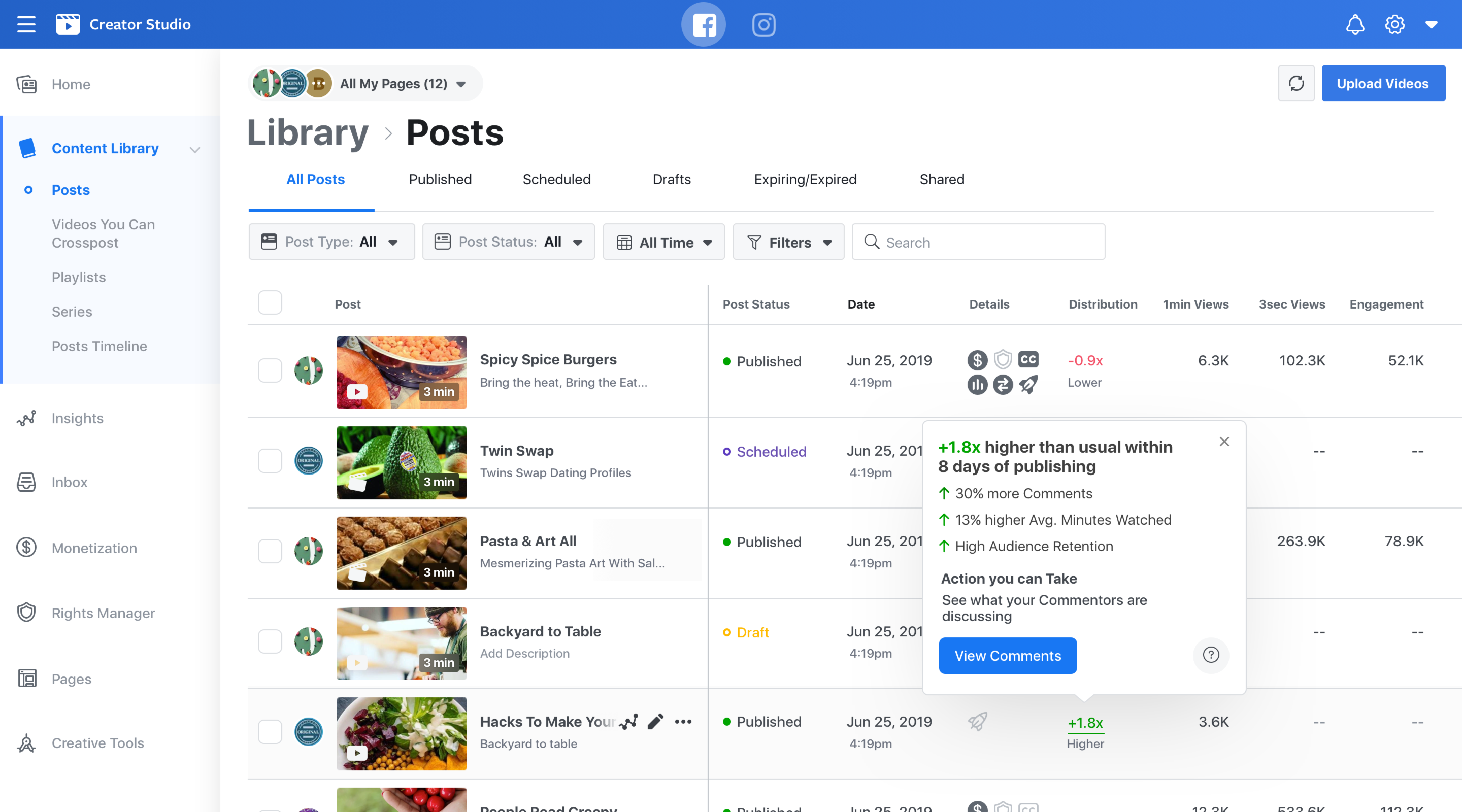
Creator Studio will also now support 13 more languages for auto-captioning: Arabic, Chinese, German, Hindi, Italian, Malay, Russian, Tagalog, Tamil, Thai, Turkish, Urdu and Vietnamese. These are in addition to those languages already available, which included English, French, Portuguese and Spanish.
Instagram - IGTV scheduling
And finally, publishers and creators will be able to publish and schedule their Instagram Feed and IGTV content for up to six months. In a few more months, Instagram Feed and IGTV drafting and editing will also become available, the company says.
This feature was already spotted in the wild before todayannouncement, and it set the social media management and influencer community abuzz. It also follows an update to the Instagram API last year to allow scheduling by third-party applications. However, a native feature is not as limited as some of those other options.
The feature is now open to all creators and publishers with Facebook Pages, whereas before some were seeing it labeled only as &coming soon& or were not able to get it working. Story scheduling is not yet included here, but it wouldn&t be surprising to see it added further down the road.
- Details
- Category: Technology
Read more: Facebook rolls out new video tools, plus Instagram and IGTV scheduling feature
Write comment (96 Comments)Automated check-out systems in supermarkets, where cashiers are replaced by barcode-readers and touchscreen interfaces for taking payments, have become a commonplace fixture in many parts of the world. But today, a startup thatbuilding what many believe will be the next generation of such systems — computer-vision-powered platforms that monitor what you take from the shelves and automatically tally it up as you are on the move so that you can leave without checking out — has raised funding to continue developing its product and help it connect with grocery retailers that have seen the advances of Amazon Go and also want to get in on the AI action without getting involved with Amazon itself.
Trigo, a computer vision startup out of Tel Aviv that is building check-out-free grocery purchasing systems specifically targeted at large supermarkets, has picked up a Series A round of $22 million. The funding is being led by Red Dot Capital, with previous Vertex Ventures Israel and Hetz Ventures also participating. This round brings the total raised by Trigo to $29 million.
The company is not disclosing its valuation, but says that it has a number of deals in place already with grocery chains, including an unspecified European chain and Shufersal, the largest grocer in Israel.
Shufersal already has plans to implement Trigosolution in 280 stores in the next five years, which speaks to the companyambitions and traction to date, even at this early stage in its development: The company says that italready piloting its camera and sensor technology in stores that are 5,000 square feet, or twice the size of a typical Amazon Go store. It&s, however, still fairly small compared to the size of a large supermarket (35,000-45,000 square feet) or even smaller challenger markets like a Trader Joeor a Lidl (20,000 square feet).
As with Amazon Go, Trigo works by implementing a series of cameras throughout a store to monitor shoppers and record what they are placing into their baskets. This is not just about being able to identify items: italso a triangulation system to ensure that people are not charged twice for items, and that items are removed from the total if they are discarded before a person leaves the store.
And itnot just to speed things up, either. Itto make shopping great again.
&I don&t actually think people really want grocery e-commerce,& Ran Peled, VP of marketing, said. &They do that because the supermarket experience has become worse with the years. We are very much committed to helping brick and mortar stores return to the time of a few decades ago, when it was fun to go to the supermarket. What would happen if a store could have an entirely new OS that is based on computer vision?&
Unlike Amazon Go, Trigo is not tied to any specific company that might potentially compete with the retailers that it is targeting, and the product can be implemented to work with loyalty cards, or without them.
However, given that Amazon has built one of the worldmost valuable companies by being both a simultaneous competitor and partner to businesses, I&m not sure that its competitor status will be a gating factor to the growth of Amazon Go, if it decides to productise it and sell the technology to other retailers… and neither does Trigo.
&The technology behind Amazon Go existed in the industry for about a decade before Amazon Go,& Peled said (Trigo was founded in 2018 by brothers Michael and Daniel Gabay). &But after it launched, it was a moment of realising, ‘Ah, this is really happening!& & Meaning, he knew now would be a fruitful period because other grocery retailers would want to get on board, and even if Amazon did roll Go out as its own service, and a service used by other retailers, there will be others who will never work with it, presenting a market opportunity to his startup.
If the endgame is bringing the time spent in the check-out phase down to zero, there are other startups working on alternative ways to reach that. Just last week, Caper raised a round of funding for a system that is based on &smart& trolleys, with sensors attached to grocery carts to take note of items and add them to your shopping bill. While the shopping cart might have the advantage of being able to more closely monitor an individualown shopping cart, store-wide systems like Trigowill potentially cost less to operate and the software might even be something that can be used on existing in-store cameras.
Interestingly, at a time when patents form one of the key ways that a company defends its intellectual property, Trigo is taking another approach. &We don&t file patents because we don&t want our technology to be public,& said Peled. &We have things that we don&t want anyone to see.& Itan ironic, if perhaps telling, stance for a computer vision company.
In the rush to build tech solutions to all the worldproblems (and if not problems, at least all the worldprocesses), there are bound to be others building further technology to bring grocery stores into the twenty-first century. Trigo presents one route to getting there, making it as much a coveted company for grocery businesses as it is for the companies that provide other services to them.
&We believe that Trigoworld-leading computer-vision team will be the first to scale this technology globally and unlock the full potential of a true grocery-wide revolution,& said Barak Salomon, managing partner of Red Dot Capital. &The process of manually scanning barcodes for each separate item at check out is outdated and time-consuming. Trigotechnology is going to save brick and mortar, revitalizing the in-store experience while keeping the best part of shopping alive.&
- Details
- Category: Technology
Read more: Trigo raises $22M for an automated grocery check-out platform, similar to Amazon Go
Write comment (98 Comments)
As more enterprise developers make use of open source, it becomes increasingly important for companies to make sure that they are complying with licensing requirements. They also need to ensure the open-source bits are being updated over time for security purposes. Thatwhere FOSSA comes in, and today the company announced an $8.5 million Series A.
The round was led by Bain Capital Ventures, with help from Costanoa Ventures and Norwest Venture Partners. Todayround brings the total raised to $11 million, according to the company.
Company founder and CEO Kevin Wang says that over the last 18 months, the startup has concentrated on building tools to help enterprises comply with their growing use of open source in a safe and legal way. He says that overall this increasing use of open source is great news for developers, and for these bigger companies in general. While it enables them to take advantage of all the innovation going on in the open-source community, they need to make sure they are in compliance.
&The enterprise is really early on this journey, and thatwhere we come in. We provide a platform to help the enterprise manage open-source usage at scale,& Wang explained. That involves three main pieces. First it tracks all of the open-source and third-party code being used inside a company. Next, it enforces licensing and security policy, and, finally, it has a reporting component. &We automate the mass reporting and compliance for all of the housekeeping that comes from using open source at scale,& he said.
The enterprise focus is relatively new for the company. It originally launched in 2017 as a tool for developers to track individual use of open source inside their programs. Wang saw a huge opportunity inside the enterprise to apply this same kind of capability inside larger organizations, which were hungry for tools to help them comply with the myriad open-source licenses out there.
&We found that there was no tooling out there that can manage the scale and breadth across all the different enterprise use cases and all the really complex mission-critical code bases,& he said. Whatmore, he found that where there were existing tools, they were vastly underutilized or didn&t provide broad enough coverage.
The company announced a $2.2 million seed round in 2017, and since then has grown from 10 to 40 employees. With todayfunding, that should increase as the company is expanding quickly. Wang reports that the startup has been tripling its revenue numbers and customer accounts year over year. The new money should help accelerate that growth and expand the product and markets it can sell into.
- Details
- Category: Technology
Read more: FOSSA scores $8.5 million Series A to help enterprise manage open-source licenses
Write comment (99 Comments)The Android tablet market isn&t exactly a hotbed of excitement and activity, which makes it all the more impressive that Samsung continues to iterate its own tablet lineup in smart, meaningful ways that push the technology forward and deliver a stellar experience. Samsungnew Galaxy Tab S6 (starting at $649.99) is no exception, and this latest offering expands the definition of what a tablet can be while retaining or refining everything thatbeen its predecessors.
Thin, light and luxe design
Samsung has been delivering outstanding body design on its tablet lineup since the introduction of the all-metal and glass Tab S4, and the Tab S6 continues this tradition with a full metal back and glass front thatlighter and thinner than its predecessor. The look and feel is more reminiscent of the Tab S5e, which was released after the S4 earlier this year and which acts as a more economical alternative to Samsungflagship lineup. The S6 manages to feel just a touch more premium than the S5e, though both are class-leading in terms of their industrial design.
The brushed finish of the back looks great, and feels nice in the hand, and if you have larger hands you can even one-hand this device when reading for limited periods of time. Samsung has also shrunk the bezels, giving you a more front face-filling screen than on any previous tablet, which does a very good job of putting the gorgeous sAMOLED display in focus. More than ever, this feels like one big sleek, metallic hand-held display — the future, in your hand, reduced to the essentials in an awesome way.
[gallery ids="1881813,1881812,1881811"]
Display and cameras
The display on the Tab S6 isn&t much changed from the one used on the Tab S5e and the Tab S4 — but thatactually great news, because Samsung has the best tablet display in the business when it comes to watching media. The 10.5-inch 2560 x 1600 pixel Super AMOLED display gives you true blacks that are outstanding, and impossible to replicate on any LED-based display, and Samsung offers a range of color options from which to choose, including &natural& settings for photo-accurate editing, and enhanced saturation modes for getting the most out of eye-popping movies and videos.
That display now comes with a neat new trick on the Tab S6: an integrated fingerprint reader. This authentication and unlock method is new for this generation, and replaces iris/face scanning as the only biometric unlock option on the Tab S4. It performs very well in my testing, and has the added cool factor of being just an amazing bit of whiz-bang tech magic, especially if this is your first time encountering an in-display fingerprint reader.
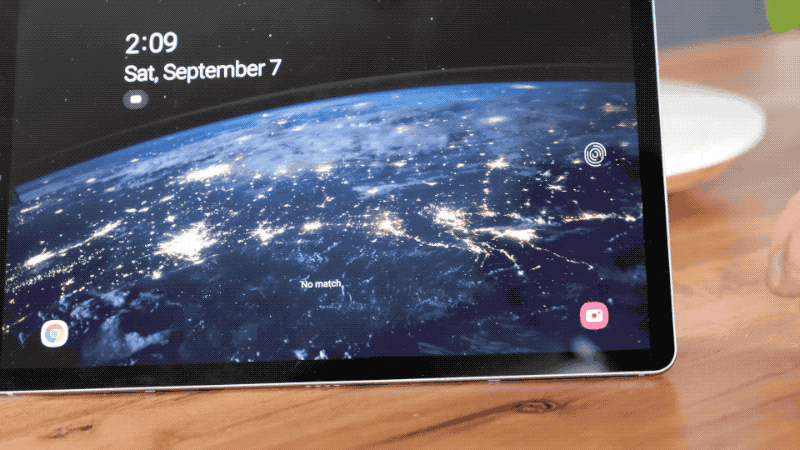
The great display makes a fantastic editing surface for photos and videos, and thatwhy itsuper interesting that Samsung went out of their way to upgrade the cameras on the Tab S6 — adding dual camera options, in fact. Therenow a super-wide-angle lens in addition to the standard one, which gives you a lot of creative options when it comes to both still photography and videos.
While the Tab S6 is great for editing, I still wouldn&t lean too heavily on the built-in cameras for actually capturing content. They&re fine cameras, augmented by Samsungbuilt-in software, but the super-wide has a fair amount of distortion and not the best resolution, and in general I still think you should avoid shooting too much with tablet cameras. Still, itnice to have the option in case you&re in a pinch.
[gallery ids="1881836,1881837,1881838,1881839"]
Your pen pal
I mentioned editing above, but the Samsung Galaxy Tab S6 has an added advantage over other tablets in this area: The S Pen. Samsungstylus is updated in this version, with Bluetooth connectivity that gives it additional superpowers like the ability to act as a remote for the camera, presentations and other software.
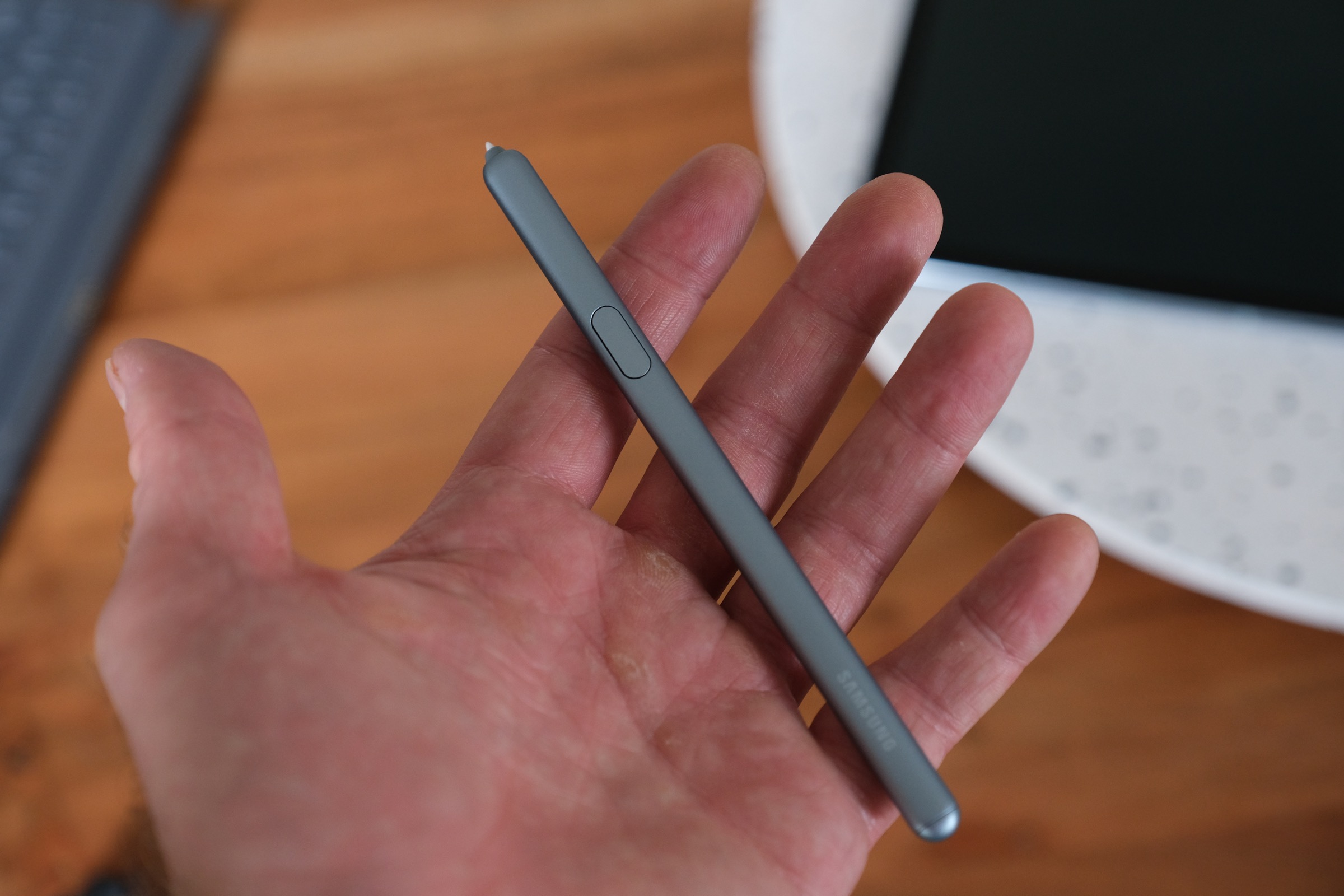 The S Pen still performs best as an actual stylus, however, and it excels in this capacity. For pressure-sensitive applications, including sketching and painting, itfantastic, but where it really shines in my usage is in editing photos using software like Lightroom from Adobe. Stylus input means you can get super specific and accurate with your edits. This applies to editing video, too, where the stylus works well for making concise trims to video timelines.
The S Pen still performs best as an actual stylus, however, and it excels in this capacity. For pressure-sensitive applications, including sketching and painting, itfantastic, but where it really shines in my usage is in editing photos using software like Lightroom from Adobe. Stylus input means you can get super specific and accurate with your edits. This applies to editing video, too, where the stylus works well for making concise trims to video timelines.
You also can easily create handwritten notes with the S Pen, and if you do so using Samsungbuilt-in Notes application, you get automatic OCR and search indexing. In my testing, I found that this worked really, really well — surprisingly so, considering how bad my handwriting is. For printed characters, the Samsung Notes app had no trouble at all identifying words accurately in my scrawl and retrieving the right results when searching by keyword.
Because this S Pen uses Bluetooth, it now has a built-in rechargeable battery. Like ApplePencil, it charges wirelessly, attaching magnetically to the tablet to power up. Samsung has designed a groove in the back of the tablet to receive the S Pen for charging, and while this isn&t sturdy enough for you to trust it to hold the stylus when you throw them in your bag unprotected, the Tab S6 cover accessory nicely wraps the S Pen with a fold-down flap for easy storage.

A true workhorse
Samsungofficial case options include a back panel protector/detachable keyboard combo that are probably the best accessory of this style available on the market for any tablet. The back cover includes a reusable sticky surface to ensure a solid fit, which will be more reliably fixed than a magnetic attachment, and it has a multi-angle kickstand that works wonderfully to support the tablet on any table or even on your lap.
As mentioned, therea top flap that provides protection and easy access to the S Pen, which is a very clever way to keep that stored without complicating matters. The cover has a finely textured surface that increases grippiness, and it has proven resilient in terms of not picking up dirt or grime so far.
[gallery ids="1881809,1881811,1881808,1881807"]
The keyboard attaches via magnets to one side of the tablet, folding up to protect the display when not in use. Itslim, but it still had defined keys with actual travel that feel really good to type with, and theresomething you probably weren&t expecting to see on an Android tablet keyboard — a built-in trackpad.
All of this is designed primarily for use with DeX, Samsungdesktop-like software experience thataimed at boosting productivity (though you can use the trackpad in the standard Android interface, too). When it works well, the DeX experience truly makes the Tab S6 feel like a mini desktop, giving you the power to tackle tasks in multiple windows — including in multiple windows for the same apps. Itgreat for things like seeing Slack open and working in multiple browser windows, along with your email client, for instance.
That said, there are definite limitations to DeX, including the need to re-open all your windows when switching back from standard Android mode, for instance. Not every app behaves well in this novel mode, either, as third-party ones especially aren&t designed for it, and there are quirks to the windowing (like overflowing and weird-sized windows) that make it occasionally a little strange to work with. Still, all in all, itgreat to have the option, and can really increase your ability to do work on the road in the right circumstances.
Bottom line
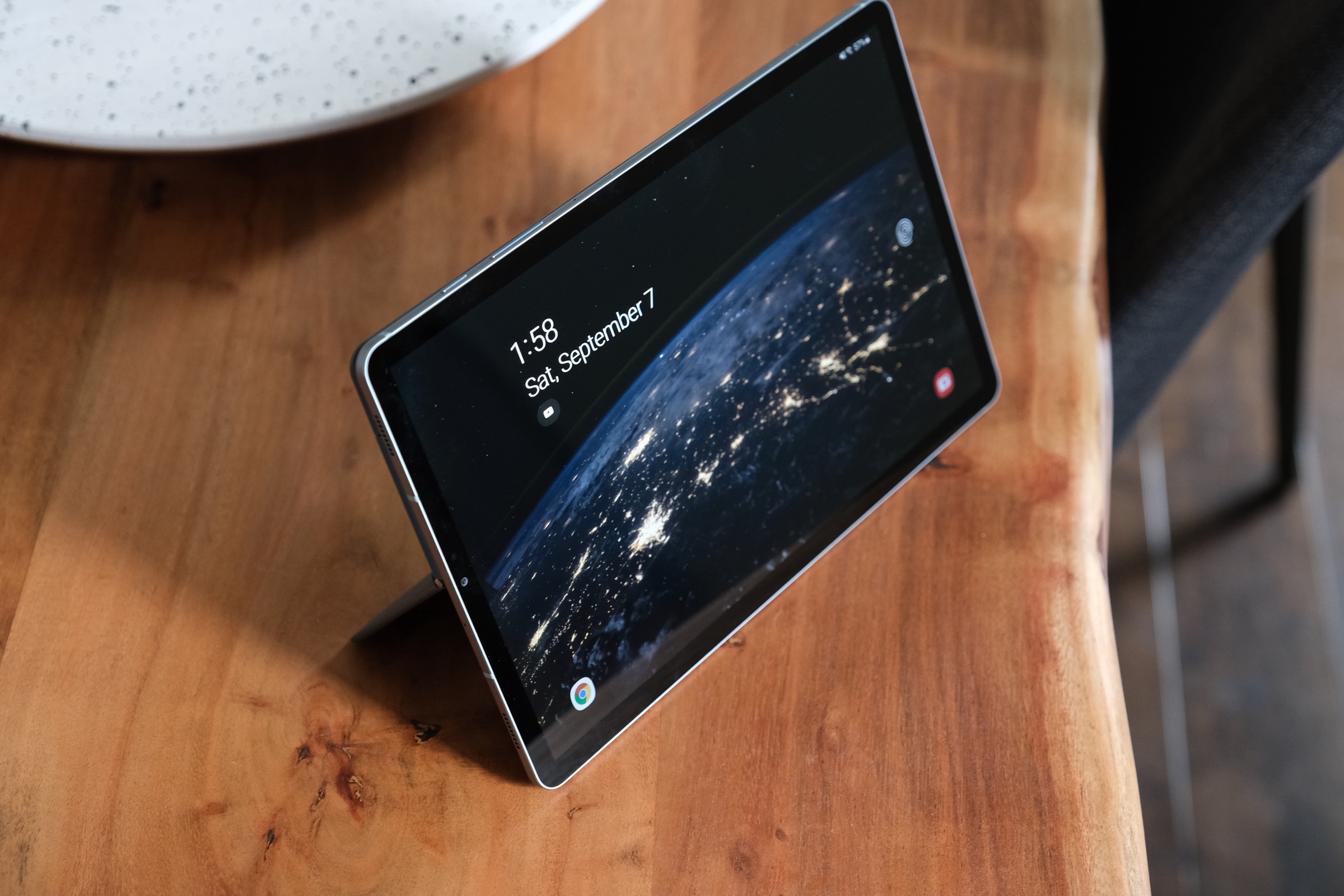
The Samsung Galaxy Tab S6 is, without a doubt, the best Android tablet available. It combines top-notch hardware with Samsungevolving DeX approach to mobile productivity, and while DeX isn&t perfect in all settings, itat the very least not doing any harm, and you&re better off having it available versus not. Meanwhile, the Tab S6 working in standard Android mode is an excellent, super-fast media consumption and photo-editing powerhouse. If you&re in the market for a tablet, the Tab S6 is an easy choice.
- Details
- Category: Technology
Read more: Samsung’s Galaxy Tab S6 combines creative flexibility with great design
Write comment (90 Comments)As legacy industries make the migration to cloud-based digital solutions to run and grow their businesses, Salesforce is hoping that it will get a cut of the action when it comes to their IT investments. The CRM giant has been doubling down on building specialised solutions for individual industry verticals, and today, it is unveiling new business units dedicated to not one but two of them: manufacturing and consumer goods.
The Manufacturing Cloud and Consumer Goods Cloud, as the two new products are called, are the latest in a list of other vertical-specific products the company has created. Other verticals targeted to date include finance, healthcare, media, nonprofits and retail.
The idea behind Salesforce strategy to build industry-specific solutions is that while the CRM and sales processes that go into manufacturing and consumer goods do have some aspects in common with other industries, both also have relatively specific requirements, too, around how sales are agreed and clients are managed.
In the case of manufacturing and consumer goods, both are capital-intensive businesses where those working on the physical products might be very removed from those working on sales (not just in terms of job functions, but in terms of the software thatused to manage each operation), or those who are in the field who are helping to distribute those goods to the people ultimately selling them.
&In the manufacturing industry, changing customer and market demands can have a devastating effect on the bottom line, so being able to understand what is happening on the ground is imperative for success,& said Cindy Bolt, SVP and GM, Salesforce Manufacturing, in a statement. &Manufacturing Cloud bridges the gap between sales and operations teams while ensuring more predictive and transparent business, so they can build deeper and more trusted relationships with their customers.&
In both the cases of manufacturing and consumer goods, Salesforce is not creating these services out of thin air: the company had already been touting solutions for both sectors as part of its bigger push into specific industries. Past acquisitions of companies like Steelbrick — a specialist in quote-to-cash solutions, a cornerstone of how manufacturing sales are made — are likely to have played a contributing role in how the new clouds were built.
With the Manufacturing Cloud, Salesforce says that it has included a feature for sales agreements that link up with a companyERP and forecasting software to be able to better predict demand from individual customers as well as the wider market. The services are also coming with more analytical insights by way of Einstein Analytics, and more functionality to work with channel partners. Third parties working with Salesforce on joint solutions using Marketing Cloud include Acumen Solutions, Deloitte and Rootstock.
The Consumer Goods Cloud has some parallel with the Manufacturing Cloud, in that both are targeting businesses that are by their nature and by legacy very rooted in physical goods and are therefore not easily &disrupted& by digital innovation. Indeed, despite all that we hear about the might of Amazon and e-commerce, a full 95% of products are still sold in physical stores. That system has a lot of drawbacks, not least of them being challenges with consumer goods brands having accurate control over how products are distributed and ultimately sold.
&Retail execution remains one of the most important pieces of a consumer goods brands strategy, but so much opportunity is wasted if the field rep doesn&t have the data and technology needed to make smart decisions,& said John Strain, GM and SVP, Retail and Consumer Goods at Salesforce, in a statement. &Consumer Goods Cloud provides these field reps with the tools they need to be successful on the ground while helping build both business opportunities and stronger relationships with their retail partners.&
The company, citing research from PwC, claims that of the $200 billion thatspent in the U.S. by consumer goods companies each year on merchandising, marketing and sales efforts for in-store sales, some $100 billion of that spend is never used in the way it was originally intended. (Thatone reason so many consumer goods companies have jumped into social media: ita way of connecting better and more directly, at least with the customers.)
That represents a huge area to tackle for a company likes Salesforce, and the Consumer Goods Cloud is the start of that effort. The product covers software that addresses areas optimising visits to stores, improving relationships with retailers, using Einstein insights for analytics and ordering software. Partners in the effort include Accenture and PwC.
Another important thing to note here is that Salesforcemove into the area comes as a competitive strike: Not only are there companies out there that have built products specifically for these markets — Sysco for consumer goods, and Atlatl Software for manufacturing, for example — but Salesforce has to contend with general rivals such as Microsoft and SAP also targeting the same potential customers.
As of last quarter, Sales Cloud now accounts for more than one-quarter of Salesforcerevenues, but todaynews underscores how &sales& is becoming a more complex and nuanced topic for the company as its business continues to grow, and as cloud-based digital processes become ever more ubiquitous across all sectors beyond simply knowledge workers. As Salesforce builds out more solutions to meet every kind of enterpriseneeds, itlikely there will be more vertical-specific tools making their way to the platform.
- Details
- Category: Technology
Read more: Salesforce doubles down on verticals, launches Manufacturing and Consumer Goods Clouds
Write comment (91 Comments)

The popular password manager LastPass has released a patch for a bug that would have allowed malicious websites to extract passwords that were previously entered using the service's browser extension.
The bug was first discovered by Google Project Zero researcher Tavis Ormandy who disclosed the vulnerability to the company early enough that it
- Details
- Category: Technology
Read more: LastPass bug could have let hackers steal your passwords
Write comment (96 Comments)Page 886 of 5614

 6
6





